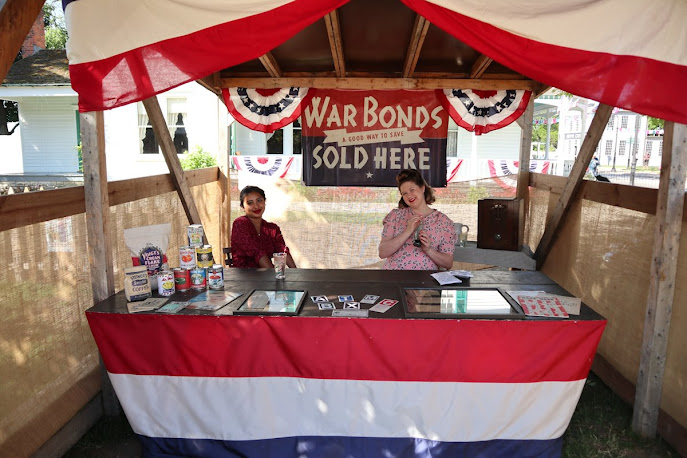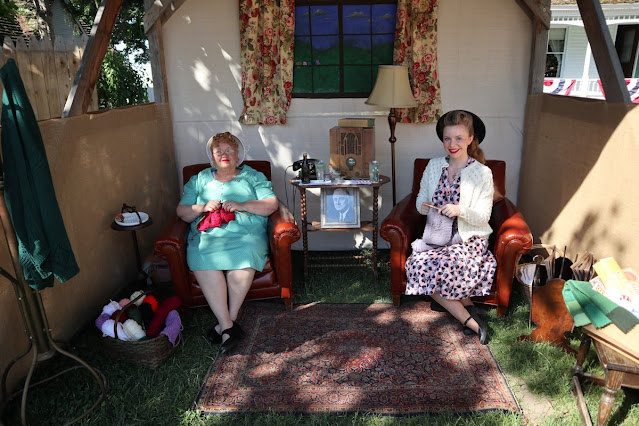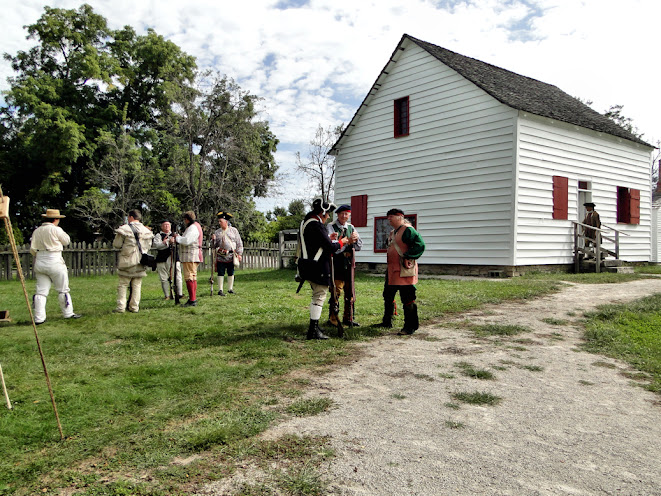Some interesting enactments and reenactments have been occurring lately, from The Battle of Lexington & Concord at Mill Race Village to 1772 spring planting at Waterloo Cabin to the Voyageurs at Port Sanilac to a timeline at Chesterfield and even to a Blacksmith and Civil War weekend (which I plan to write about later in July). The one I will write about this week took place over Father's Day Weekend and wasn't really a reenactment per se, but, instead, kind of more like living history based around automobiles and their eras. As Greenfield Village worded it on their web page:
Nearly 20 million Americans answered the call. They planted gardens in backyards, empty lots and even city rooftops. Neighbors pooled their resources, planted different kinds of foods and formed cooperatives, all in the name of patriotism.
Kick summer into high gear this Father’s Day weekend in Greenfield Village. Motor Muster, one of the country’s most exciting historic vehicle shows, transports you to the golden eras of car culture all weekend long.
Hundreds of car owners show off the talent that goes into preserving and restoring these living connections to the past, and experts share the history and insights at pass-in-review parades. Every automobile, from luxury vehicles to gritty muscle cars, has been carefully chosen to guide you through a unique story of American drive.
Cruise through a diverse collection of vehicles, and enjoy rare opportunities to step inside immersive vignettes from five of the American auto industry’s most formative decades. From the lean Depression-era ’30s and the American home front during World War II to the futuristic ’50s, revolutionary ’60s and bicentennial ’70s, get a unique perspective on American culture through the lens of what we drove.
Now I will have a few car photos here, but I concentrated more on the vignettes, particularly the one depicting WWII.
In fact, there is a story to be told here:
As part of the war effort, the government rationed foods like sugar, butter, milk, cheese, eggs, coffee, meat and canned goods. Labor and transportation shortages made it hard to harvest and move fruits and vegetables to market. So, the government turned to its citizens and encouraged them to plant "Victory Gardens." They wanted individuals to provide their own fruits and vegetables.
 |
| While outside we have older sister, Gigi, working on her Victory Garden. |
Magazines such as the Saturday Evening Post and Life printed stories about victory gardens, and women's magazines gave instructions on how to grow and preserve garden produce. Families were encouraged to can their own vegetables to save commercial canned goods for the troops.
 |
| You have to love her patriotic "Keep Out" sign. |
In 1943, families bought 315,000 pressure cookers (used in the process of canning), compared to 66,000 in 1942. The government and businesses urged people to make gardening a family and community effort.
 |
| It sure does look like Gigi is doing a fine job with her Victory Garden! |
 |
| Yes, Gigi is proud to do her part! |
The result of victory gardening? The US Department of Agriculture estimates that more than 20 million victory gardens were planted. Fruit and vegetables harvested in these home and community plots was estimated to be 9-10 million tons, an amount equal to all commercial production of fresh vegetables. So, the program made a difference.
When World War II ended, so did the government promotion of victory gardens. Many people did not plant a garden in the spring of 1946, but agriculture had not yet geared up to full production for grocery stores, so the country experienced some food shortages.
Oh, not a teenager, mind you, but, rather, a young adult.
Aside from getting married, young folks in their 20s in the 1940s were doing all kinds of new-fangled things like hanging out and developing their own culture of music, dance, fashion, and cars. The youth culture would evolve into the carefree rock and roll society of the 1950s.
 |
| "Oh, Mother! I am so tired of the news! I would like to hear music - something happy!" |
 |
| "You really should be helping out with the War effort like your sisters instead of wasting your time reading magazines." |
 |
| Jillian did some 1940s style posing for me. |
Jill and the other ladies who reenact this period with her have taken their living history to another level: they play baseball.
 |
| ~One of my favorite poses~ Jill belongs to the South Bend Blue Sox Living History baseball Team. Yes, she plays WWII women's baseball (think: "A League of Their Own"). |
In 1943, with so many men off fighting overseas, Philip K. Wrigley founded the All-American Girls Professional Baseball League. To find players for a women’s league, Wrigley sent scouts out across the United States, Canada and Cuba. A total of 60 women made the cut for the first 1943 season, and were divided among four teams: the South Bend Blue Sox, based in Indiana; the Rockford Peaches, based in Illinois; and the Kenosha Comets and the Racine Belles, both based in Wisconsin. Over 600 women played in the league, which eventually consisted of 10 teams located in the American Midwest. The league actually continued after our boys were brought home once they won the War: in 1948, league attendance peaked at over 900,000 spectators!
 |
| Here are a few of the cars Jill would have seen as she moved along the street. Without the sign to remind her the year of the cars, of course! |
The last time the United States issued war bonds was during World War II, when full employment collided with rationing, and war bonds were seen as a way to remove money from circulation as well as reduce inflation. Issued by the U.S. Government, they were first called Defense Bonds. The name was changed to War Bonds after the Japanese attack on Pearl Harbor, December 7, 1941.
The war bonds sold in the US helped the government raise about $185 billion. Bonds were bought by over 84 million Americans.
Though patriotism reigned during this time, propaganda from war bond drives—colorful, insistent, and maybe even a little guilt-inducing—played a big part in our visual sense of the history of the home front.
By the end of the war, millions of tons of materials including scrap metal, rope, paper, and even waste fat from stoves, had been collected and put to use. Nearly every county in the country had its own salvage committee or salvage board operating in mobilizing both the efforts of everyday Americans, but also in reaffirming the message of why it was so important.
 |
| There was no guilt here - these ladies did a fine job representing those from the early 1940s. |
 |
"There's my sister, always working in her Victory Garden!" |
On January 10, 1942, only one month following the devastating attacks on Pearl Harbor, the United States launched one of its most important and also most memorable domestic initiatives of the entire war: the “Salvage For Victory” campaign. The campaign asked that all Americans do their part in supporting the new war effort by collecting, saving, conserving, and recycling materials that could be repurposed for military uses.
 | ||
| Scrap drives were a popular way for everyone to contribute to the war effort. By recycling unused or unwanted metal for example, the government could build ships, airplanes and other equipment needed to fight the war.
|
Despite not taking place on an overseas battlefield, this marshaling the strengths of millions of Americans to “Get In The Scrap” should not be overlooked for its importance or its lingering evocative powers.
I love the music of WWII.
........................
I love the cars.
I love the culture.
and
I loved hearing the stories of the era from my mom and dad.
But, as much as I enjoy seeing the reenactments of this time - and the reenactors do such an amazing job at it - it's a period that I personally have little interest in doing.
As an older male, the clothing does very little for me, and the fact that much of my life had a strong 1940s flavor to it while growing up; hearing the stories when friends and family would visit, while music of the era played on the hi fi...and even seeing the popular actors and musicians on TV - - yeah, it was my parents' time (my father was in the army stationed in Okinawa in 1945, and my mother worked at a dime store in Detroit, and loved serving the men in uniform - that's how she met my dad), and to replicate their lives, for me, would be, simply put, weird. I grew up hearing their stories first-hand, and as interesting as they were, I have no want to reenact that time; I prefer the pre-electric eras - those days before the electric light, before the automobile, before telephones and phonographs, before movies and radio...
But I am so glad these ladies (and the others) do bring this period to life, and in a well-researched manner. My hat is off to them.
Of course, extra thanks to Jillian for her wonderful poses!
~ ~ ~
Until next time, see you in time.









































